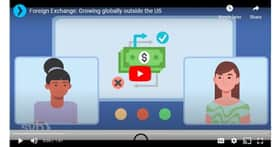Key Takeaways
- Watch three videos below to learn about foreign payments and receivables.
- Wiring US dollars overseas is likely not the best way to pay foreign invoices.
- Invoicing in US dollars may be convenient for you but what about your foreign clients?
Global Payments - How to get started
Hiring talent overseas, importing goods or offering products and services to international customers can be critical for growing your business. Scaling globally is an exciting next step for your company, but it can also be challenging. There are many cultural, operational and financial considerations to take into account, including the local currency exchange rate.
When doing business in global markets, you will need to make payments and receive funds in foreign currency. Foreign exchange – specifically converting foreign currency into dollars and vice versa – is a key component to consider when expanding internationally.
To assist you as you expand your global reach, here are answers to three common foreign exchange questions that business owners ask:
1. How do I get started?
First, evaluate your objective. Are you looking to increase your customer base in Europe? Do you want to hire developers in Asia? Once you know your objective, you can identify the function of your global payments plan. The operational nature of your business will determine the most effective model for making and/or receiving foreign funds. Contact your relationship manager at SVB to connect with the SVB Global Payments and Foreign Exchange team to get started on the path to international expansion.
Watch our video, Foreign exchange: Growing globally outside the US to see how we can help simplify your overseas payments.
2. How do I pay vendors and contractors in foreign countries?
If you’re importing goods or hiring overseas talent, you will need to send payments abroad. Though sending US dollar (USD) wires internationally is an option, sending payments in the local currency may be a more efficient and cost-effective approach. SVB makes it easy via online banking. You can make direct payments or set up a model for reoccurring expenses to pay contractors in their local currency – giving you greater visibility into exchange rates as well as the total amount of funds received.
Watch our video, Foreign exchange: Making a foreign payment to learn more about your options for overseas payments.
3. How do I collect payments from international customers?
If you plan on selling goods or services in another country, it may be practical to collect payment in the local currency. While setting up a foreign account is an option, SVB can simplify the process by collecting foreign currency on your behalf, converting it to US dollars and applying the funds to your company’s SVB account on the same day. This simplifies the process and gives you a consolidated financial view in US dollars.
Watch our video, Foreign exchange: Receiving a foreign payment to learn more about receiving payments from foreign customers.
Carefully consider your key business objectives before expanding internationally. You’ll want to get it right the first time to avoid costly mistakes that might cause unforeseen delays and expenses. As you scale, these early decisions will have a greater impact on your operations. Your partners in the SVB Global Payments and Foreign Exchange team can help you navigate through the complexities when expanding beyond US borders.
To learn more about how SVB can support your business when growing global, reach out to your SVB FX contact or GroupFXRiskAdvisory@svb.com.



